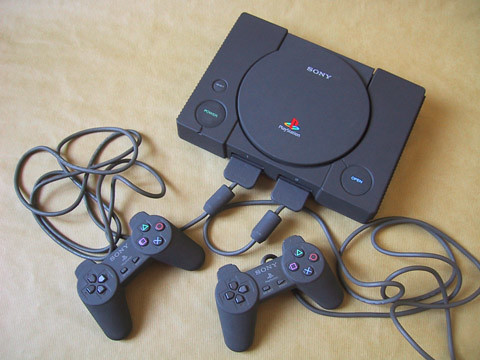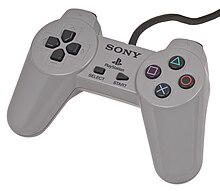With all this talk going around of different retro gaming platforms, and with the launch of the PlayStation 4 looming, it seems the PS1 hasn't gotten its share of love yet. I'd say it ranks only behind the Super NES as my favorite platform of all time... the inexpensive CD media and low licensing costs led to a huge push for a deluge unique software which may be unmatched at any other point in gaming history.

About The System:
The story of Sony and Nintendo teaming up to build a CD-ROM for the Super NES is well-worn, so I won't go into too much detail. Nintendo approached Sony to develop a CD-ROM add-on for the Super NES, dubbed the "SNES-CD". A contract was signed, and work began. Sony also planned to develop a Super Nintendo-compatible, Sony-branded console, but one which would be more of a home entertainment system playing both Super Nintendo cartridges and a new CD format which Sony would design. This was also to be the format used in SNES-CDs, giving a large degree of control to Sony despite Nintendo's leading position in the video gaming market. The product, dubbed the "Play Station" was to be announced at the May 1991 Consumer Electronics Show (CES). However, when Nintendo's Hiroshi Yamauchi read the original 1988 contract between Sony and Nintendo, he realized that the earlier agreement essentially handed Sony complete control over any and all titles written on the SNES CD-ROM format. Yamauchi decided that the contract was totally unacceptable and he secretly canceled all plans for the joint Nintendo-Sony SNES CD attachment. Instead of announcing a partnership between Sony and Nintendo, at 9 am the day of the CES, Nintendo chairman Howard Lincoln stepped onto the stage and revealed that Nintendo was now allied with Philips, and Nintendo was planning on abandoning all the previous work Nintendo and Sony had accomplished. Lincoln and Minoru Arakawa had, unbeknownst to Sony, flown to Philips headquarters in Europe and formed an alliance of a decidedly different nature—one that would give Nintendo total control over its licenses on Philips machines.
After the collapse of the joint project, Sony considered halting their research, but ultimately the company decided to use what they had developed so far and make it into a complete, stand-alone console...
The PlayStation was Sony's entry into the console market. Released in Japan on December 3, 1994, with its US release on September 1995, the system made an immediate splash. The texture-mapped 3D graphics were ahead of any other console at the time and the price (following a legendary announcement by Phil Harrison at E3 1995) was a reasonable $300, $100 less than its direct competitor, the Sega Saturn.
With an array of impressive 3rd party development deals, an attractive price, competitive technology, and the storage space of CD-ROM, the PS1 dominated the industry, eventually selling 102 million consoles, with production stopping in March 2006, a few months before the PlayStation 3's release.
Hardware Stats:
Media: 2x CD-ROM, with a maximum data throughput of 300 kB/s
CPU: MIPS R3000A-family R3051 @ 33.8688 MHz
Geometry Transformation Engine:
-Resides inside the main CPU chip, giving it additional vector math instructions used for 3D graphics
-Operating performance of 66 MIPS
-360,000 polygons per second
-180,000 texture mapped and light-sourced polygons per second
GPU:
-Handles 2D graphics processing separate from the main 3D engine on the CPU
-Maximum of 16.7 million colors (24-bit color depth)
-Resolutions from 256 × 224 to 640 × 480
-Adjustable frame buffer
-Unlimited color lookup tables
-Emulation of simultaneous backgrounds (for parallax scrolling)
-Flat or Gouraud shading and texture mapping
-1 MB of VRAM
RAM: 2 MB of main RAM, 1 MB video RAM,
Sound:
-Supports ADPCM sources with up to 24 channels
-Sampling rate of up to 44.1 kHz
-512 kB of memory
So quaint compared to the 8 GIG GDDR5 we have nowadays!

Hardware/Peripherals:

On July 7, 2000, Sony issued a redesigned console, dubbed the "PSOne", which had a much smaller form-factor, and enabled a screen to be attached for pseudo-portable gaming.

The Net Yaroze was a debugging unit that enabled homebrew developers to run code on the system, and included some software development libraries. In a way, it was like the Xbox Live Indie Games of its day. I have limited information on the Net Yaroze or its games (though I vaguely remember one called "Gas Girl", a 2D platformer about a farting girl, that was mentioned in an old Next Generation mag).

The famous Memory Card! Many a Christmas morning was ruined when people, used to saving on their cartridges, didn't realize they needed a Memory Card to save their PS1 games. With storage space of a paltry 128kb, divided into 15 "Blocks", you really needed to stock up on them if you wanted to keep your save. Some games would take up all 15 blocks (such as an RPG Maker project)!


The original controller shipped with a D-pad, 4 shoulder buttons (L1/L2/R1/R2), a Start button, Select button, and 4 face buttons. In 1997, Sony released the Dual Analog controller, and then followed with the DualShock in 1997/1998. These controller added 2 analog sticks to better 3D movement, and the DualShock added rumble, no doubt spurred on by the Nintendo 64's Rumble Pack. The DualShock was a popular design that is still in use today, though it seems Sony is finally making a few long-overdue changes with the PlayStation 4.
Links:
Wikipedia Page about the system
John Szczepaniak's Gamasutra article on the Net Yaroze
Ken Kutaragi - Father of the PlayStation (Wikipedia)
PS1 RPG Classics That Hold Up
Games That Defined The History of the PS1 (Racketboy)
Video Links:
The Bootup Sequence
Sony's PS1 Retrospective
100 PlayStation Games in 10 Minutes
PS1 Collecting - Hidden Gems
Complete PS1 RPG List
Top 150 Japan-Only PS1 games Part 1 (Part 2) (Part 3)
Game Recommendations:
The PS1 has one of the greatest lineup of games in history, with a whopping 2418 games across all 3 regions. Every genre imaginable (aside from nascent ones like MMOs and MOBAs) is well-represented here, though the system has a deserved reputation for being an RPG powerhouse. Many games pushed the limits of their respective genres and even to this day, there are nothing else on the market like them.
RPG: Star Ocean 2, Valkyrie Profile, Xenogears, Final Fantasy VII/VIII/IX/Origins/Tactics, Suikoden, Suikoden II, Wild Arms, Vandal Hearts, Persona 2: Eternal Punishment, Arc the Lad Collection, Chrono Cross, Grandia, Brave Fencer Musashi, Threads of Fate, SaGa Frontier 1/2, Breath of Fire III/IV, Tactics Ogre, Tales of Destiny, Tales of Eternia (Destiny 2), Vagrant Story
Fighting: Tekken 1/2/3, Soul Blade, Tobal no. 1, Bushido Blade, Bushido Blade 2
2D Action: Castlevania: Symphony of the Night, Tomba 1/2, Mega Man X4
3D Action: Metal Gear Solid, Crash Bandicoot 1/2/3, Ape Escape, Spyro The Dragon, Legacy of Kain: Soul Reaver
Racing: Wipeout 1/XL/3, Gran Turismo 1/2, R4: Ridge Racer 4
Shoot-em-up: Einhander, R-Type Delta, Starfighter Sanvein, In The Hunt
Survival Horror: Resident Evil 1/2/3, Silent Hill, Galerians
First-Person Shooter: DOOM, Medal of Honor
Puzzle: Intelligent Qube, Trap Gunner, Super Puzzle Fighter 2 Turbo
Miscellaneous: PaRappa The Rapper, Um Jammer Lammy, Tail of the Sun, Aquanaut's Holiday, Carnage Heart, Bust A Groove
Import/Japanese: Gunners Heaven (a decent Gunstar Heroes knockoff), NOTAM of Wind (the best hot-air balloon simulator ever!), Tales of Phantasia Remix (gorgeous 2D graphical update to the Super Famicom RPG), iS: Internal Section (tube shooter from Squaresoft with beautiful psychedelic graphics), PoPoLoCrois (cutesy strategy RPG), Adventures of Little Ralph (gorgeous 2D sidescroller), Tobal 2 (impressive 3D fighter), Vib Ribbon (rhythm game with minimalist "scribble" graphics), Gradius Gaiden (one of the best Gradius games ever)
I will update this post with other great recommendations too... but the PS1's library was so extensive, it's hard to get everything! And also, if you see any errors or things to add, or have any cool graphics you can make, please let me know, it's my first time making a thread like this

